Design, Fabrication and Characterization of Molybdenum Field Emitter Arrays (Mo-FEAs)
Abstract
:1. Introduction
2. Design and Theoretical Analysis
3. Fabrication Processes
4. Experimental Results and Discussions
5. Conclusions
Acknowledgments
Author Contributions
Conflicts of Interest
References
- Fursey, G.N. Field emission in vacuum micro-electronics. Appl. Surf. Sci. 2003, 215, 113–134. [Google Scholar] [CrossRef]
- Kim, Y.C.; Park, S.H.; Lee, C.S.; Chung, T.W.; Cho, E.S.; Chung, D.S.; Han, I.T. A 46-inch diagonal carbon nanotube field emission backlight for liquid crystal display. Carbon 2015, 91, 304–310. [Google Scholar] [CrossRef]
- Zhang, Z.P.; Chen, D.K.; Chen, W.Q.; Chen, Y.C.; Song, X.M.; Zhan, R.Z.; Deng, S.Z.; Xu, N.S.; Chen, J. Thermo-Enhanced Field Emission from ZnO Nanowires: Role of Defects and Application in a Diode Flat Panel X-ray Source. Appl. Surf. Sci. 2017, 399, 337–345. [Google Scholar] [CrossRef]
- Zhu, N.L.; Xu, K.S.; Song, L.; Chen, J. Fabrication and characterization of bulk molybdenum field emission arrays. In Proceedings of the 2015 Transducers, 18th International Conference on Solid-State Sensors, Actuators and Microsystems, Anchorage, AK, USA, 21–25 June 2015; pp. 1168–1171. [Google Scholar]
- Wu, Z.S.; Pei, S.F.; Ren, W.C.; Tang, D.M.; Gao, L.B.; Liu, B.L.; Li, F.; Liu, C.; Cheng, H.M. Field Emission of Single-Layer Graphene Films Prepared by Electrophoretic Deposition. Adv. Mater. 2009, 21, 1756–1760. [Google Scholar] [CrossRef]
- Li, Y.H.; Sun, Y.H.; Jaffray, D.A.; Yeow, J.T. A novel field emission microscopy method to study field emission characteristics of freestanding carbon nanotube array. Nanotechnology 2017, 28, 155704. [Google Scholar] [CrossRef] [PubMed]
- Collins, C.M.; Parmee, R.J.; Milne, W.I.; Cole, M.T. High Performance Field Emitters. Adv. Sci. 2016, 3, 1500318. [Google Scholar] [CrossRef] [PubMed]
- Parmee, R.J.; Collins, C.M.; Milne, W.I.; Cole, M.T. X-ray generation using carbon nanotubes. Nano Converg. 2015, 2, 1. [Google Scholar] [CrossRef]
- Zhu, N.L.; Xu, K.S.; Zhai, Y.S.; Tao, Z.; Di, Y.S.; Zhang, Z.P.; Chen, J.; Cole, M.T.; Milne, W.I.; Chen, J. Bulk Molybdenum Spindt Field Emission Arrays. Funct. Nanostruct. 2016, 1, 22–25. [Google Scholar]
- Zhu, N.L.; Xu, K.S.; Zhai, Y.S.; Tao, Z.; Chen, J. Self-aligned, Gated Bulk Molybdnum Field Emitter Arrays. In Proceedings of the IEEE 29th International Conference on Micro Electro Mechanical Systems, Shanghai, China, 24–28 January 2016; pp. 1082–1085. [Google Scholar]
- Jha, A.; Roy, R.; Sen, D.; Chattopadhyay, K.K. Curvature aided efficient axial field emission from carbon nanofiber-reduced graphene oxide superstructures on tungsten wire substrate. Appl. Surf. Sci. 2016, 366, 448–454. [Google Scholar] [CrossRef]
- Wang, A.H.; Zhong, Z.G.; Lu, C.; Lv, L.X.; Wang, X.C.; Zhang, B.L. Study on field-emission characteristics of electrodeposited Co-doped ZnO thin films. Phys. B Condens. Matter 2011, 406, 1049–1052. [Google Scholar] [CrossRef]
- Cui, Y.; Chen, J.; Zhang, X.; Lei, W. Flexible field emission devices based on barium oxide nanowires. J. Disp. Technol. 2015, 12, 466–471. [Google Scholar] [CrossRef]
- Wang, F.; Lu, B.Q. Well-aligned MoO2, nanowires arrays: Synthesis and field emission properties. Phys. B Condens. Matter 2009, 404, 1901–1904. [Google Scholar] [CrossRef]
- Shao, P.R.; Deng, S.Z.; Chen, J.; Chen, J.; Xu, N.S. Study of field emission, electrical transport, and their correlation of individual single CuO nanowires. J. Appl. Phys. 2011, 109, 023710. [Google Scholar] [CrossRef]
- Kim, H.; Seo, S.W.; Park, J.W.; Lee, Y.H.; Jang, J.; Ju, B.K. Development of a cold-cathode electron gun for cathode-ray tube using a Mo-tip field-emitter array. J. Vac. Sci. Technol. B Nanotechnol. Microelectron. 2003, 21, 43–47. [Google Scholar] [CrossRef]
- Zhou, J.; Xu, N.S.; Deng, S.Z.; Chen, J.; She, J.C.; Wang, Z.L. Large-area nanowire arrays of molybdenum and molybdenum oxides: Synthesis and field emission properties. Adv. Mater. 2003, 15, 1835–1840. [Google Scholar] [CrossRef]
- Bala, A.; Singh, P.; Nautiyal, T.; Auluck, S. Theoretical studies on electronic and magnetic properties of ultrathin mo nanowires. J. Appl. Phys. 2010, 107, 024307. [Google Scholar] [CrossRef]
- Spindt, C.A. A Thin-Film Field-Emission Cathode. J. Appl. Phys. 1968, 39, 3504. [Google Scholar] [CrossRef]
- Spindt, C.A.; Brodie, I.; Humphrey, L.; Westerberg, E.R. Physical properties of thin-film field emission cathodes with molybdenum cones. J. Appl. Phys. 1976, 47, 5248. [Google Scholar] [CrossRef]
- Spindt, C.; Holland, C.E.; Schwoebel, P.R. 11.1: A reliable improved Spindt cathode design for high currents. In Proceedings of the 2010 IEEE International Vacuum Electronics Conference, Monterey, CA, USA, 18–20 May 2010; pp. 201–202. [Google Scholar]
- Harris, J.R.; Jensen, K.L.; Shiffler, D.A. Physical electrostatics of small field emitter arrays/cluster. J. Appl. Phys. 2016, 119, 043301. [Google Scholar] [CrossRef]
- Fowler, R.H.; Nordheim, L. Electron emission in intense electric fields. Proc. R. Soc. Lond. A 1928, 119, 173–181. [Google Scholar] [CrossRef]
- Fomani, A.A.; Guerrera, S.A.; Velasquez-Garcia, L.F.; Akinwande, A.I.T. Toward amp-level field emission with large-area arrays of Pt-coated self-aligned gated nanoscale tips. IEEE Trans. Electron. Devices 2014, 61, 2538–2546. [Google Scholar] [CrossRef]
- Barbour, J.P.; Dolan, W.W.; Trolan, J.K.; Martin, E.E.; Dyke, W.P. Space-charge effects in field emission. Phys. Rev. 1953, 92, 45–51. [Google Scholar] [CrossRef]
- Zhu, N.L.; Cole, M.T.; Milne, W.I.; Chen, J. Bulk molybdenum field emitters by inductively coupled plasma etching. Phys. Chem. Chem. Phys. 2016, 18, 33152–33157. [Google Scholar] [CrossRef] [PubMed]
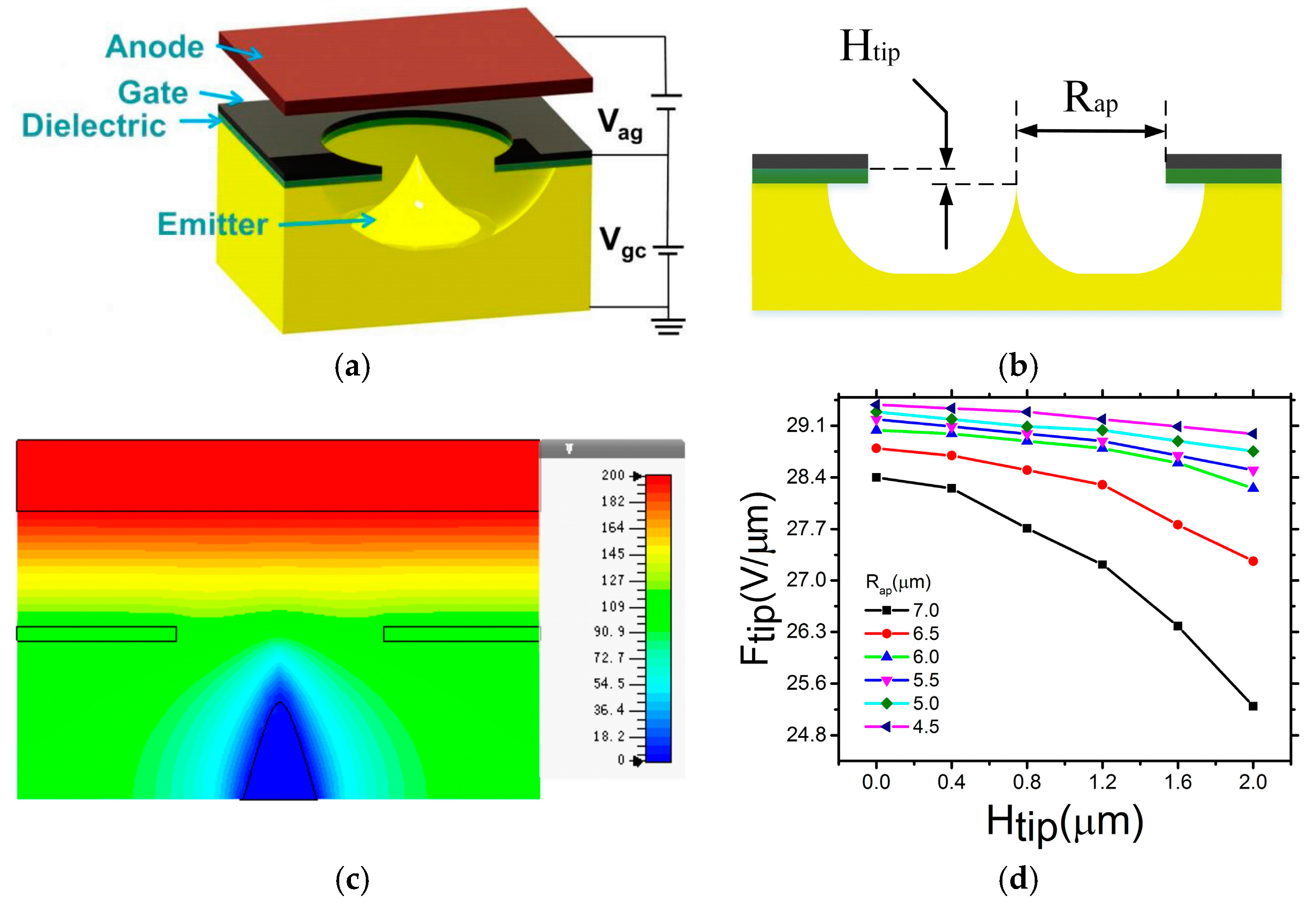
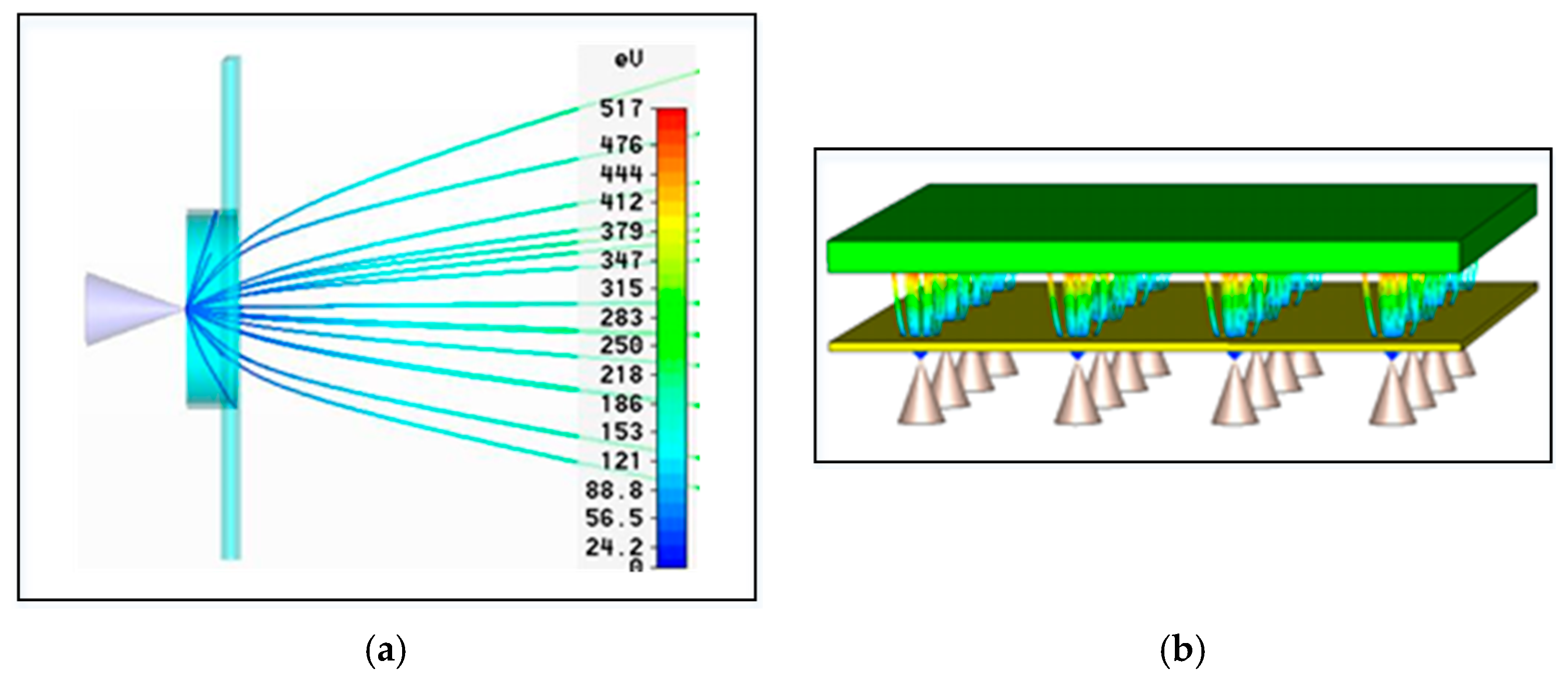
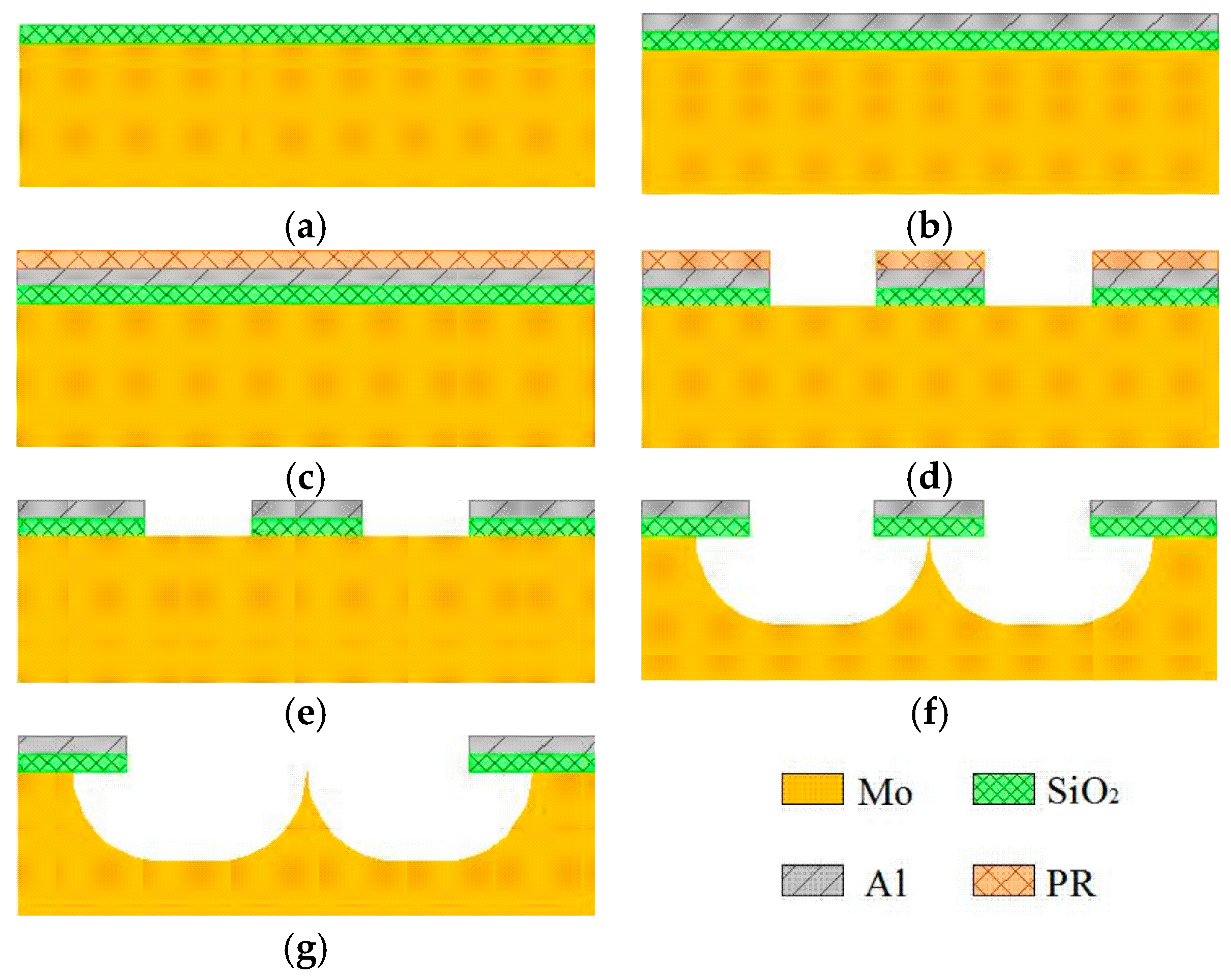
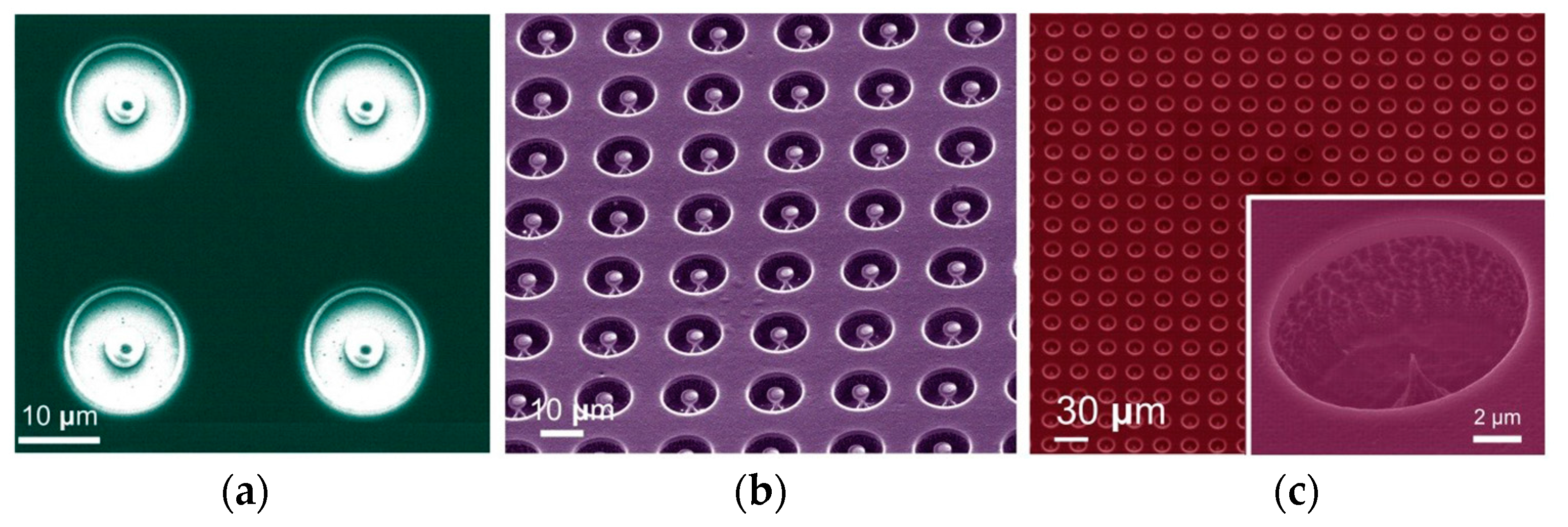
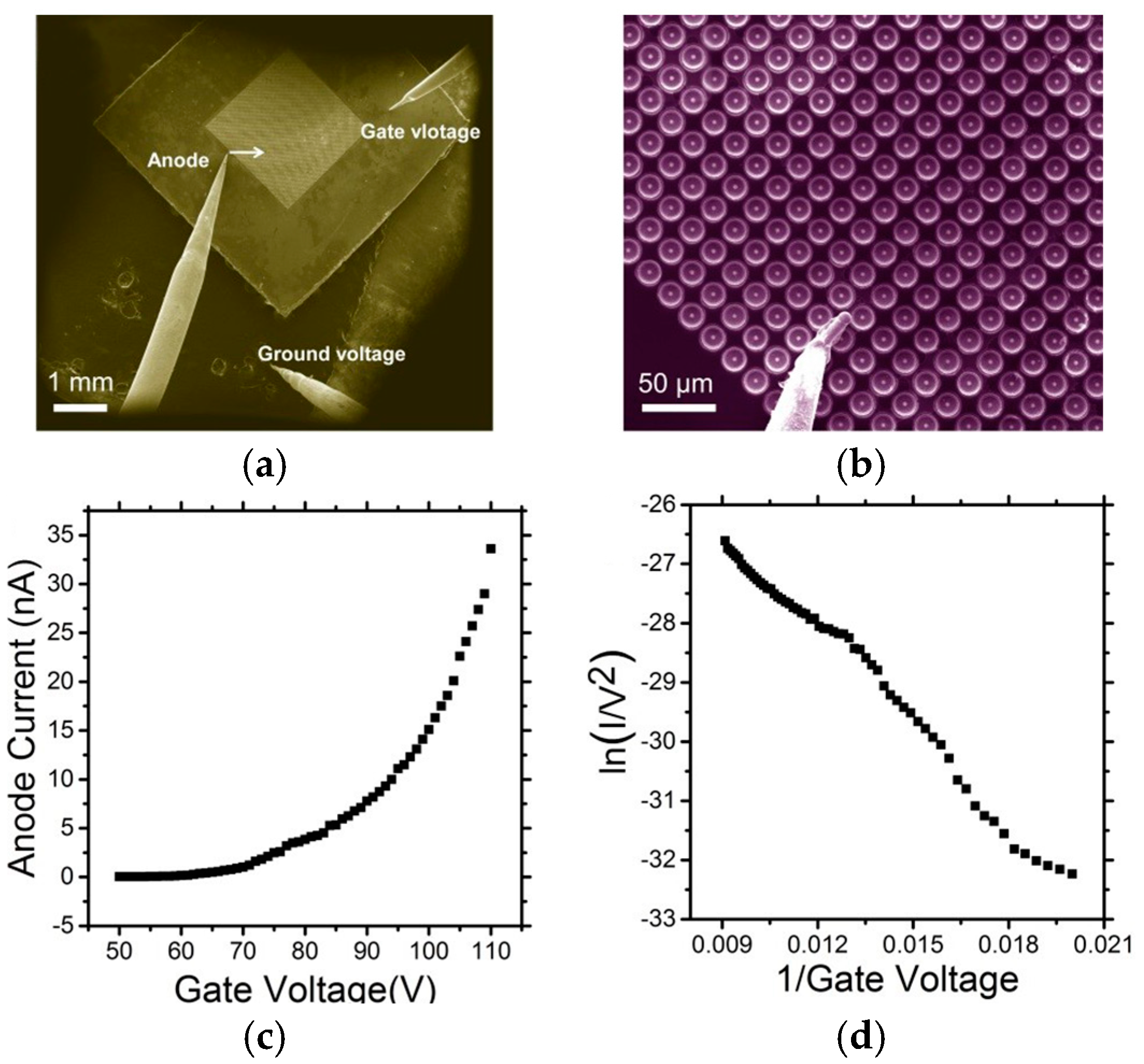
© 2017 by the authors. Licensee MDPI, Basel, Switzerland. This article is an open access article distributed under the terms and conditions of the Creative Commons Attribution (CC BY) license (http://creativecommons.org/licenses/by/4.0/).
Share and Cite
Zhu, N.; Chen, J. Design, Fabrication and Characterization of Molybdenum Field Emitter Arrays (Mo-FEAs). Micromachines 2017, 8, 162. https://doi.org/10.3390/mi8050162
Zhu N, Chen J. Design, Fabrication and Characterization of Molybdenum Field Emitter Arrays (Mo-FEAs). Micromachines. 2017; 8(5):162. https://doi.org/10.3390/mi8050162
Chicago/Turabian StyleZhu, Ningli, and Jing Chen. 2017. "Design, Fabrication and Characterization of Molybdenum Field Emitter Arrays (Mo-FEAs)" Micromachines 8, no. 5: 162. https://doi.org/10.3390/mi8050162
APA StyleZhu, N., & Chen, J. (2017). Design, Fabrication and Characterization of Molybdenum Field Emitter Arrays (Mo-FEAs). Micromachines, 8(5), 162. https://doi.org/10.3390/mi8050162




